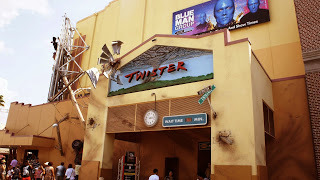A History of Twister: Ride It Out at Universal Studios Florida
 Universal executives were always on the hunt for intellectual properties or technologies that they could exploit. Any film with a clear vision and extensive special effects was game. Amblin Entertainment’s Twister (1996) seemed like a perfect fit. The special effects loaded film was based on the adventures of scientists who chase after tornados. Bringing a tornado indoors and repeating the show dozens of times a day would be an impressive feat of engineering. The project was inspired by a sculpture from artist Ned Kahn who specialized in sculpting tornadoes and vortexes with installations in science centers around the world. A Universal executive saw one of his pieces that generated a vortex in San Francisco and realized that the illusion looked like a small tornado. The team at Universal Creative began work on creating a larger vortex and hired wind-flow experts Cermak Peterka Petersen, Inc. The firm had worked on more than 2,000 projects including the World Trade Towers in New York. The goal was to create a reliable indoor tornado that was approximately five stories tall and twelve feet wide. If successful they would have built the largest indoor tornado ever created by man. They began by building a one-fourth scale model of the vortex, which worked beautifully. Feeling confident, the model was scaled up to full size. That is when the problems started. To generate the full size effect, it was necessary to generate constant winds of 35 miles per hour. A studio was outfitted with thirty specially designed fans arranged in three tiers; ground level, mid level, and high level. Eighteen of those fans had blades seven feet tall. “We invited our employees into the ride," said J. Michael Hightower, the project director. "It had a detrimental effect on the tornado. This special effect is the most difficult at Universal because we don’t have direct control over it. For instance, if we want the Jaws shark to move faster, we just turn up the pressure.” A computerized weather tracking system was installed that monitored the outside wind velocity, humidity and barometric pressure to maximize the size and shape of the twister inside. They brought in 240 mannequins with clothes to tweak the effect. The result was a reliable tornado of the correct size that could move as much as thirty feet in any direction from its origin. The volume of air used could fill four full-size airborne blimps. Spending the project budget on spectacular, memorable special effects instead of a ride mechanism made financial sense. Plus, the box-office success of the film, therefore it’s visibility, was high on the priority list for both Warner Bros. and Universal who jointly produced the film. When the $16 million Twister: Ride It Out opened on May 4, 1997, it represented a new level of sophistication in special effects demonstrations. Like the other special effects demonstrations, the show was broken into three acts each in a different setting. The first act was a preshow that included an audio-visual presentation. The second room resembled a tornado damaged building. The two stars of the film, Bill Paxton and Helen Hunt, were filmed separately for their introductions and shown on two separate screens because of reports that they did not like each other. The final act took place inside of a 25,000 square foot soundstage on a set that resembled an outdoor scene. Visitors filed on to a elevated viewing platform and come face to face with more than fifty-five special effects. Hundreds of xenon strobes flash, simulating lightning. The sound of thunder was piped through fifty-four speakers powered by 42,000 watts, enough to power five average homes. The roar of the hurricane was made of a combination of sounds including camel sounds, lion roars, and backward human and animal screams. More than 65,000 gallons of recycled water fed the rainstorm and could be ready for the next show every six minutes. The twenty laser disc players, three-hundred speakers, and sixty video monitors were connected by fifty miles of electrical wire, and controlled by twenty computers. One of the most memorable effects from both the movie and the show was a flying cow.
Universal executives were always on the hunt for intellectual properties or technologies that they could exploit. Any film with a clear vision and extensive special effects was game. Amblin Entertainment’s Twister (1996) seemed like a perfect fit. The special effects loaded film was based on the adventures of scientists who chase after tornados. Bringing a tornado indoors and repeating the show dozens of times a day would be an impressive feat of engineering. The project was inspired by a sculpture from artist Ned Kahn who specialized in sculpting tornadoes and vortexes with installations in science centers around the world. A Universal executive saw one of his pieces that generated a vortex in San Francisco and realized that the illusion looked like a small tornado. The team at Universal Creative began work on creating a larger vortex and hired wind-flow experts Cermak Peterka Petersen, Inc. The firm had worked on more than 2,000 projects including the World Trade Towers in New York. The goal was to create a reliable indoor tornado that was approximately five stories tall and twelve feet wide. If successful they would have built the largest indoor tornado ever created by man. They began by building a one-fourth scale model of the vortex, which worked beautifully. Feeling confident, the model was scaled up to full size. That is when the problems started. To generate the full size effect, it was necessary to generate constant winds of 35 miles per hour. A studio was outfitted with thirty specially designed fans arranged in three tiers; ground level, mid level, and high level. Eighteen of those fans had blades seven feet tall. “We invited our employees into the ride," said J. Michael Hightower, the project director. "It had a detrimental effect on the tornado. This special effect is the most difficult at Universal because we don’t have direct control over it. For instance, if we want the Jaws shark to move faster, we just turn up the pressure.” A computerized weather tracking system was installed that monitored the outside wind velocity, humidity and barometric pressure to maximize the size and shape of the twister inside. They brought in 240 mannequins with clothes to tweak the effect. The result was a reliable tornado of the correct size that could move as much as thirty feet in any direction from its origin. The volume of air used could fill four full-size airborne blimps. Spending the project budget on spectacular, memorable special effects instead of a ride mechanism made financial sense. Plus, the box-office success of the film, therefore it’s visibility, was high on the priority list for both Warner Bros. and Universal who jointly produced the film. When the $16 million Twister: Ride It Out opened on May 4, 1997, it represented a new level of sophistication in special effects demonstrations. Like the other special effects demonstrations, the show was broken into three acts each in a different setting. The first act was a preshow that included an audio-visual presentation. The second room resembled a tornado damaged building. The two stars of the film, Bill Paxton and Helen Hunt, were filmed separately for their introductions and shown on two separate screens because of reports that they did not like each other. The final act took place inside of a 25,000 square foot soundstage on a set that resembled an outdoor scene. Visitors filed on to a elevated viewing platform and come face to face with more than fifty-five special effects. Hundreds of xenon strobes flash, simulating lightning. The sound of thunder was piped through fifty-four speakers powered by 42,000 watts, enough to power five average homes. The roar of the hurricane was made of a combination of sounds including camel sounds, lion roars, and backward human and animal screams. More than 65,000 gallons of recycled water fed the rainstorm and could be ready for the next show every six minutes. The twenty laser disc players, three-hundred speakers, and sixty video monitors were connected by fifty miles of electrical wire, and controlled by twenty computers. One of the most memorable effects from both the movie and the show was a flying cow. The show replaced the Ghostbusters Spectacular in the New York zone. The grand opening was originally scheduled to open in April 1997 but was delayed one month due to tornados that killed forty-two people in Central Florida in February of that year. Universal donated $100,000 to aid the victims. Shortly after the opening, Reel EFX, Inc. sued Universal over the faux weather effect technology used in the Twister attraction.
Published on October 28, 2013 06:00
No comments have been added yet.



